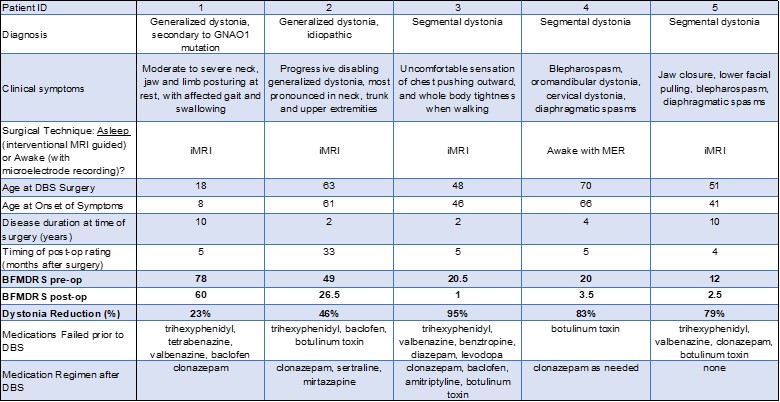Objective: To describe the results of pallidal Deep Brain Stimulation (DBS) in a single center for dystonia subtypes which previously have not been widely reported.
Background: Dystonia, characterized by sustained or intermittent muscle contractions, is a syndrome with multiple etiologies. Patients with primary dystonia who are medically-refractory have shown variable but overall favorable response to DBS, and these outcomes are well described for isolated cervical dystonia and monogenic dystonia such as DYT1, DYT3, DYT6, and DYT11 [1]. However, there is a need to understand the application of DBS for less commonly reported dystonia subtypes including other primary generalized dystonias [2,3] and segmental dystonia.
Method: We assessed clinical outcomes for all patients with underreported primary dystonia who were treated with DBS targeting bilateral globus pallidus interna (GPi) from 2020-2022 in a single center. Patients were excluded if dystonia was an isolated cervical dystonia, or due to DYT1, DYT3, DYT6, or DYT11 mutation. Videos of patients’ neurologic exams were reviewed by a movement disorder specialist, and dystonia severity was scored pre- and post-operatively (typically 4-6 months) using the Burke-Fahn-Marsden Dystonia Rating Scale (BFMDRS) [4].
Results: Five patients were identified meeting the inclusion criteria. These included two cases of generalized dystonia, one idiopathic with normal genetic testing and one secondary to GNAO1 mutation, and three cases with midline segmental dystonias affecting two or more areas such as the trunk, diaphragm, eyelids, and oromandibular region. Mean age at time of surgery was 50 years (range: 18-70), with DBS performed on average 5.6 years (range: 2-10) following onset of dystonia. BFMDRS improved in the generalized dystonia cases by 23% (78/60) in case 1, and 46% (49/26.5) in case 2. In the segmental dystonias, BFMDRS decreased by 95% (20.5/1) in case 3, 83% (20/3.5) in case 4, and 79% (12/2.5) in case 5 [table1].
Conclusion: GPi DBS led to improvement in dystonia severity in all five of these patients with underreported dystonia subtypes. Benefits were marked in the segmental dystonia cases, and less pronounced for generalized dystonia. Despite the inherent limitations of a small case series, these reports are critical to expanding on the indications for DBS and helping guide decision-making for other dystonia subtype patients considering DBS.
References: [1] Tisch S, Kumar KR. Pallidal Deep Brain Stimulation for Monogenic Dystonia: The Effect of Gene on Outcome. Front Neurol. 2021;11:630391. Published 2021 Jan 8. doi:10.3389/fneur.2020.630391
[2] Koy A, Cirak S, Gonzalez V, et al. Deep brain stimulation is effective in pediatric patients with GNAO1 associated severe hyperkinesia. J Neurol Sci. 2018;391:31-39. doi:10.1016/j.jns.2018.05.018
[3] Casagrande SCB, Listik C, Coelho DB, et al. Deep Brain Stimulation in Patients with Isolated Generalized Dystonia Caused by PRKRA Mutation. Mov Disord Clin Pract. 2019;6(7):616-618. Published 2019 Jul 17. doi:10.1002/mdc3.12811
[4] Burke RE, Fahn S, Marsden CD, Bressman SB, Moskowitz C, Friedman J. Validity and reliability of a rating scale for the primary torsion dystonias. Neurology. 1985;35(1):73-77. doi:10.1212/wnl.35.1.73
To cite this abstract in AMA style:
B. Dahlben, N. Bukhari-Parlakturk, DA. Turner, S. Harward, D. Southwell, KT. Mitchell. Deep Brain Stimulation Outcomes in Underreported Dystonias: A Case Series [abstract]. Mov Disord. 2023; 38 (suppl 1). https://www.mdsabstracts.org/abstract/deep-brain-stimulation-outcomes-in-underreported-dystonias-a-case-series/. Accessed November 28, 2025.« Back to 2023 International Congress
MDS Abstracts - https://www.mdsabstracts.org/abstract/deep-brain-stimulation-outcomes-in-underreported-dystonias-a-case-series/

